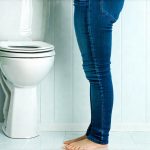The sensation of relief after urination is something most people take for granted – a natural consequence of emptying the bladder. It’s often described as a comforting release, a lessening of pressure that signifies normalcy. However, when this feeling is fleeting, vanishing almost as quickly as it arrives, it can understandably cause concern and prompt questions about what might be happening within the body. This isn’t necessarily indicative of a serious problem; many factors, ranging from simple hydration levels to temporary physiological responses, can play a role. But recognizing when a short-lived sense of relief after peeing is worth investigating further is crucial for proactive health management.
This article explores the various reasons why you might experience momentary bladder relief that doesn’t last, focusing on common causes and differentiating between those that are generally benign and those that warrant medical attention. We’ll delve into the complexities of urinary function, examining how different conditions can impact this sensation, and discuss potential next steps if you find yourself consistently experiencing this phenomenon. It’s important to remember that self-diagnosis is never recommended; seeking professional guidance from a healthcare provider is always the best course of action when dealing with health concerns.
Understanding the Basics of Urinary Function
The urinary system is a remarkably efficient network responsible for filtering waste products from the blood and eliminating them from the body as urine. This process involves several key players: the kidneys, which filter the blood; the ureters, which transport urine from the kidneys to the bladder; the bladder itself, which stores urine; and the urethra, through which urine is expelled. Normal bladder function relies on a coordinated effort between these components. When the bladder fills, stretch receptors send signals to the brain, creating the urge to urinate. Upon urination, these receptors diminish, providing that initial sense of relief. This relief is directly tied to the reduction in pressure on the bladder walls and the associated neurological feedback loop.
However, this system isn’t always straightforward. Several factors can disrupt this process, leading to a diminished or fleeting sensation of relief. These include things like:
– Hydration levels: Dehydration concentrates urine, potentially irritating the bladder even after emptying it.
– Nerve sensitivity: Variations in nerve function can alter how we perceive bladder fullness and relief.
– Muscle tone: Weakened pelvic floor muscles (more common with age or after childbirth) can affect bladder control and sensation.
– Underlying medical conditions: Certain health issues, discussed later, can directly impact urinary function and the associated feelings of relief.
The feeling of relief isn’t just about emptying the bladder; it’s also linked to psychological factors. Stress and anxiety can sometimes exacerbate symptoms or influence how we interpret bodily sensations. Therefore, understanding the interplay between physical and mental well-being is essential when assessing this issue. A holistic approach that considers both aspects provides a more accurate picture of what’s happening.
Common Causes of Temporary Relief
Many benign explanations can account for experiencing relief after urinating that quickly fades. One frequent culprit is overactive bladder (OAB), even in its milder forms. OAB isn’t necessarily about needing to pee more often, but rather feeling a strong and sudden urge to urinate, even when the bladder isn’t full. This can lead to quick trips to the bathroom followed by a rapid return of urgency because the bladder hasn’t truly been emptied enough – or, more accurately, the sensation of fullness quickly returns due to heightened nerve sensitivity.
Another common cause is related to fluid intake and type. Consuming large amounts of liquids, particularly diuretics like caffeine or alcohol, can overwhelm the kidneys and lead to frequent urination that doesn’t feel substantially relieving. Similarly, certain foods (spicy foods, citrus fruits) can irritate the bladder lining, causing a sense of urgency even after voiding. Often, these are temporary issues easily addressed by adjusting lifestyle factors – staying adequately hydrated with water, limiting diuretic beverages, and avoiding bladder irritants. A simple adjustment in daily habits may be all that’s needed to restore a comfortable urinary experience.
Investigating Potential Underlying Conditions
If the fleeting relief persists despite lifestyle adjustments, it’s important to consider potential underlying medical conditions. Urinary tract infections (UTIs) are among the most common culprits. While often associated with burning sensations during urination and frequent urges, some UTIs can present with subtle symptoms, including a quick loss of relief after voiding. This is because inflammation within the urinary tract disrupts normal bladder function and nerve signaling.
Another possibility to explore is interstitial cystitis (IC), also known as painful bladder syndrome. IC is a chronic condition characterized by bladder pain and frequent urination, often without an identifiable infection. The exact cause of IC remains unknown, but it’s believed to involve inflammation and damage to the bladder lining. Patients with IC frequently report feeling relief immediately after urinating, only for that relief to vanish quickly as the underlying inflammation continues to irritate the bladder. It’s crucial to note that diagnosing IC can be challenging and requires a thorough medical evaluation.
Finally, in men, prostate enlargement (benign prostatic hyperplasia or BPH) can obstruct urine flow and lead to incomplete bladder emptying. This results in a feeling of urgency even shortly after urinating because the bladder isn’t fully relieved. While BPH is more common with age, it’s essential to rule out this possibility, especially if other symptoms like weak urine stream or difficulty starting urination are present. A medical professional can perform tests to assess prostate health and determine whether BPH is contributing to the issue.
When to Seek Medical Attention
Determining when a fleeting sense of relief after peeing warrants a visit to the doctor can be tricky, as many factors influence this decision. Generally, if the symptom persists for more than a few weeks, significantly impacts your quality of life, or is accompanied by other concerning symptoms, seeking medical evaluation is advisable. These additional symptoms might include:
– Fever or chills (suggesting a UTI)
– Blood in urine (hematuria)
– Painful urination (dysuria)
– Lower back pain
– Difficulty urinating or weak urine stream
A healthcare provider can perform a physical exam, review your medical history, and order appropriate tests to determine the underlying cause of the problem. These tests may include:
1. Urine analysis: To check for infection or other abnormalities.
2. Cystoscopy: A procedure where a thin, flexible tube with a camera is inserted into the urethra to visualize the bladder.
3. Urodynamic testing: A series of tests that assess bladder function and urinary flow.
It’s important to be honest and detailed when describing your symptoms to your doctor. Providing accurate information about the frequency, duration, and associated symptoms will help them make an accurate diagnosis and recommend the most appropriate course of treatment. Remember, early intervention is often key to managing urinary issues effectively.
Managing Symptoms & Promoting Bladder Health
While waiting for a medical evaluation or following your healthcare provider’s recommendations, there are several steps you can take to manage symptoms and promote overall bladder health. Lifestyle modifications remain foundational:
– Maintain adequate hydration: Drink enough water throughout the day, but avoid excessive fluid intake before bedtime.
– Limit bladder irritants: Reduce consumption of caffeine, alcohol, spicy foods, and citrus fruits.
– Practice pelvic floor exercises (Kegels): Strengthening these muscles can improve bladder control and reduce urgency.
– Empty your bladder completely: Take your time when urinating and ensure you’ve fully emptied your bladder.
Beyond lifestyle changes, bladder training techniques may also be helpful. This involves gradually increasing the intervals between urination to retrain the bladder and improve its capacity. However, it’s important to note that bladder training should only be attempted under the guidance of a healthcare professional, as it may not be suitable for all individuals. Ultimately, proactive management combined with prompt medical attention is crucial for addressing fleeting relief after peeing and restoring comfortable urinary function.





















